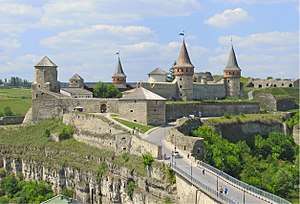Kodak Fortress
Kodak fortress (Ukrainian: Кодак; Polish: Kudak) was a fort built in 1635[1] by the order of the Polish king Władysław IV Vasa and the Sejm on the Dnieper River near what would become the town of Stari Kodaky (now near the city of Dnipro in Ukraine).[2] In 1711, according to the Treaty of the Pruth the fortress was destroyed by the Muscovites.
History
It was constructed by Stanisław Koniecpolski to control Cossacks of the Zaporizhian Sich, to prevent Ukrainian peasants from joining forces with the Cossacks and to guard the southeastern corner of the Polish-Lithuanian Commonwealth. The Poles tried to establish order in that area, and commissioned French military cartographer and engineer William le Vasseur de Beauplan to construct the fort. Building cost around 100,000 Polish zlotys. The dragoon garrison was commanded by the French officer Jean de Marion.
Shortly after construction was completed in July 1635, in the Sulima Uprising, the Cossack forces of Ivan Sulima captured the fortress in a surprise attack on the night of August 11/12, 1635. The Cossacks killed the entire German mercenary garrison (numbering 200 men) and demolished the fortress.
The Poles hired the German engineer Friedrich Getkant and rebuilt Kodak, three times larger, in 1639. The fortress contained a Catholic church with monastery and an Orthodox church. Its garrison increased to 600, with artillery support. About two miles outside of the fortress was erected a huge guard tower. The governor of that fortress became Jan Zoltowski while its commandant became Adam Koniecpolski (a nephew of Stanisław).
During the Khmelnytsky Uprising of 1648, Krzysztof Lada-Grodzicki commanded the fortress. It surrendered to the Cossacks on October 1, 1648, after a 7-month siege, upon hearing the news of Polish defeat at the Battle of Pyliavtsi on September 23, 1648. Rank and file defenders were massacred or drowned in the river after they had left Kodak upon capitulation. The Cossacks sold the Kodak commander and some other officers to the Tatars as slaves.[3]
After the Treaty of Pereyaslav in 1654, Kodak fortress was manned by the Cossacks. Peter I of Russia razed it in accordance with the terms of the Treaty of the Pruth with the Ottoman Empire in 1711.
The Soviet government attempted to destroy the remnants of fortress in order to eradicate traces of Polish influence on Ukraine by establishing a quarry on the site in 1944. The quarry closed in 1994, but by then two thirds of fortress was completely destroyed.
As of 2015 the site consists only of ruins, but it has become a popular tourist attraction.
Gallery
 Old fortifications at the site of Kodak Fortress
Old fortifications at the site of Kodak Fortress A memorial on the site of Kodak Fortress
A memorial on the site of Kodak Fortress Old cemetery in the village of Stari Kodaky, near the site of Kodak Fortress. The River Dnieper is in the background.
Old cemetery in the village of Stari Kodaky, near the site of Kodak Fortress. The River Dnieper is in the background.
References
- Above Kodak, by Mykola Chaban, THE DAY WEEKLY DIGEST, #28, Thursday, 20 May 2010
- "Виповнюється 380 років з часу зведення над Дніпром фортеці Кодак". Gorod.dp.ua. Retrieved 2020-06-11.
- Maryan Dubiecki, Kudak: twierdza kresowa i jej okolice, Warszawa, Gebethner i Wolff, 1900, pp. 151-152.
Bibliography
- (in Polish) Czołowski A., Kudak. Przyczynki do założenia i upadku twierdzy. (Notes to the establishment and destruction of the fortress) "Kwartalnik Historyczny" (Historical Quarterly) R. 40:1926, pp 161–184
External links
- http://www.fortified-places.com/kudak/
- Historical overview (in Ukrainian)
